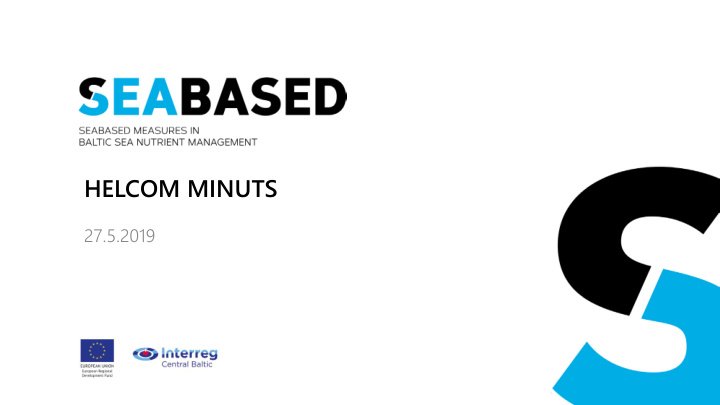



HELCOM MINUTS 27.5.2019
Seabased Outputs WP Binding Phosphorus WP Guidelines WP Marine Habitat Bank WP Sustainability WP Sediment removal into sediment Practical Guidelines on Concept of Marine Sustainability Phosphorus load Phosphorus load Habitat Bank assessment for reduction by binding reduction from the seabased measures seabased measures soluble phosphorus in sediment in pilot Ecosystem restoration bottom sediment in areas measures for pilot areas developing and testing the Concept
Project Seabased • SWE: • Stockholm University, DEEP • County Administrative Board of Östergötland • FI: • The Government of Åland • The Centre for Economic Development, Transport and the Environment for Southwest Finland • The Åland Fish farmers’ Association • John Nurminen Foundation (Lead Partner) • Duration: 3/2018 – 2/2021
Seabased pilots • Binding phosphorus into sediment with marl (merkel) • Two sites in Sweden • One site in Finland • Removing top layer sediment • 1-3 sites in Finland • Management fishing • Stickleback fishing at the Åland Islands • Irrigation of agricultural fields with nutrient-rich bottom waters at the Åland Islands • Site selection: • Full anoxia, preferably reduced land-based load • Availability of earlier monitoring information/data • Semi-enclosed coastal areas
Field work – pilot exploration Sediment and Acoustic depth survey water samples
Sustainability • Different aspects of sustainability • Risk assessment and methods • Ecological and environmental • Thorough compilation of existing information on the environment • Economic • Familiarization to the pilot method • Social • Sediment and water analyses before • Legislative and after the pilots • Local information events, communication with local people • Legal consultation for the permit process • Expected results • Awareness of the challenges and potential related to sediment removal • Guidelines for implementing seabased measures in a sustainable way
Risk assessment framework for seabased measures Gathering top-level scientists in Baltic Sea marine • ecology and geochemical processes in the marine environment to identify effects (positive and negative) of seabased measures on biological, chemical and hydrological processes. Note: focus on natural science based facts! • Assessing the scale, time and significance of different • impacts. Impacts of no action also included. Conclusions: • What are the most significant risks? • Weighing ecosystem risks against ecosystem benefits • What do we know, where are the knowledge gaps, and • which knowledge gaps prevent decision making – how to focus future research? Which impacts are acceptable and which are not - no-go • –situations? Consensus and dissensus: on what we can agree and on • what we have a disagreement?
Lessons learned so far • Include proper monitoring – prior and after - and scientific knowledge in the pilots • Pilot site selection! • Resources for monitoring • Knowledge within the project group • Without quantitative information on effects, cost-effectiveness cannot be assessed • Methods are not technically mature for large scale implementation in the open sea area • … neither social acceptability and scientific consensus
www.seabasedmeasures.eu
Recommend
More recommend